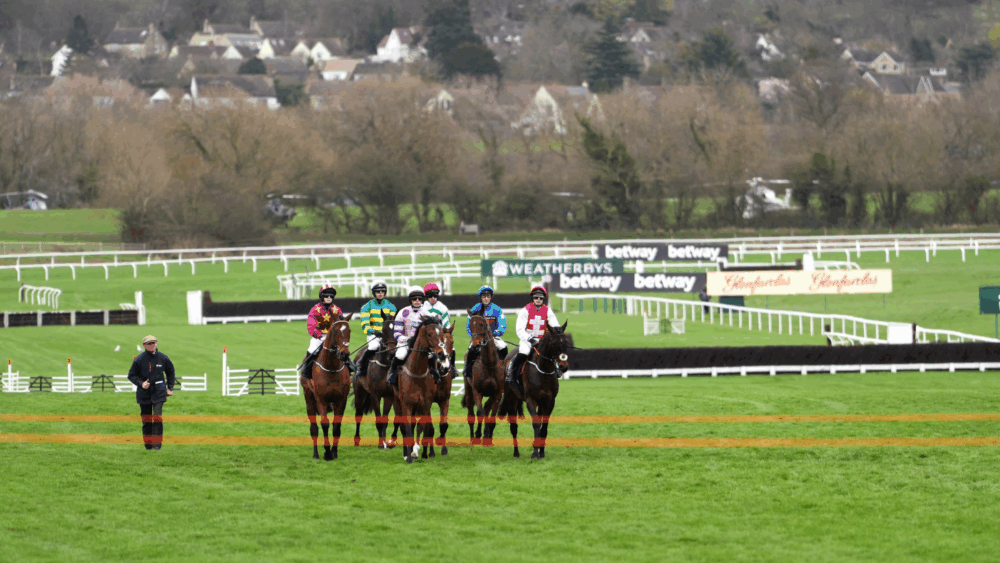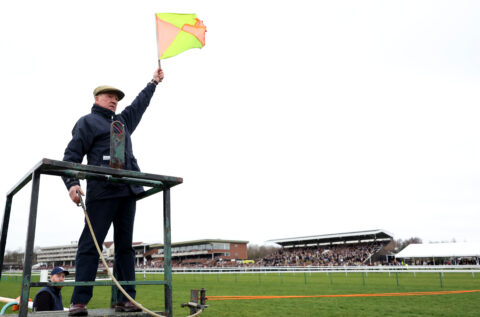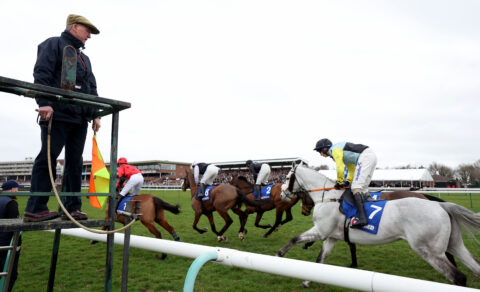Jumps Starts – How do they work and what Rules govern them?

The start of a Jumps race is an event that requires co-operation between starters and jockeys in order to ensure a fair opportunity for all.
With a new season upon us, we thought it would be helpful to run through some of the key points governing how races are started, as well a reminder of when horses can and cannot be declared a non-runner due to incidents at the start.
The Start of a Race
Fundamental to any great race is a fair start, one that allows everybody competing, their connections and those in the betting public the opportunity to see the best horse on the day win without fear of losing their chance before the race gets going in earnest.
With that in mind, starting our races fairly and safely is of huge significance. The current method, supported by the Rules of Racing, has been developed following consultation with jockeys and the wider industry and is designed to foster a strong working relationship between the jockeys and the starters.
Indeed, it came about when matters relating to the starts of races came to a head more than a decade ago and a review and consultation in 2014 led to the creation of the current way of doing things, taking in extensive feedback from starters and jockeys.
Here’s how it works.
Prior to the arrival of horses at the start, the starting team tests the starting mechanism to ensure it is working as required and is ready for the arrival of the field.
Having presented themselves for girth checks by the starters upon arrival at the start, the jockeys will await their instruction to line-up and must not do so until they receive this instruction. Only at this time have all officials confirmed that the race is safe to begin.
When all necessary checks have been completed, the starter mounts the rostrum, regardless of the race-start time, with the starter on the ground continuing to issue instructions to jockeys at this point.

When ready to do so, the starter on the rostrum will raise the start flag to invite the field to begin walking towards the tape. Jockeys must not begin walking forward until the flag is raised and they must do so only as a walk or jig-jog. The advance flag operator will simultaneously raise their flag.
While verbal instructions may also be given, the main focus of the jockeys must be on the starter’s flag. When the starter is happy that the field is approaching the tape at the correct pace and that all horses have the opportunity to start on safe and fair terms, the start will be effected by the simultaneous releasing of the tape and dropping of the flag.

Considerations for the Starter
The BHA’s team of starters are vastly experienced and include many former jockeys. Trust between them and the jockeys lining up to compete is paramount to the successful execution of starts, and so there are a number of factors any starter considers prior to dropping their flag.
The starter’s authority must be clear to prevent horses from beginning on uneven terms and often the starter on duty on a given day will speak to jockeys before racing begins to remind them of their responsibilities under the Rules of Racing and set out their expectations for the day ahead.
A key element in executing a fair start is ensuring that, as mentioned above, horses are not approaching the tape at anything faster than a walk or jig-jog. Criticism can often come when observers see horses in a good line but starting to speed up, with many wondering why they cannot simply be sent on their way.
The reason for this is simple, and this is one of the most important aspects of the starting process – should the starters “just let them go” despite some horses approaching at faster than a jig jog, then not only would the horses who are approaching the tapes at the correct speed be disadvantaged in the race in question, but also the trust between starters and jockeys would be broken. Jockeys must know that if they follow the rules and approach at the correct speed then they are not going to be put at a disadvantage.

Jockeys may only begin to approach the tape when the starter has raised their flag, because it is only at this point that the starter is ready to begin the race. This creates consistency for all involved and prevents confusion that would arise if horses approached in their own time. If the flag has not been raised, this will usually mean that we have not reached the race start time, or that some other clearance, for example medical or veterinary, has not been given.
The starter will then hold the flag up for a period of time to aid the execution of a fair start. If the flag was to be raised up and dropped down quickly, this could lead to jockeys seeking to anticipate the start and create unfairness – again, the process is all about fostering trust in what jockeys can expect from the starter and what they can expect in return.
The distance from which fields begin to approach the starting tape will vary depending upon the layout of the course and the nature of the race and field that is present. Raceday officials work with their racecourse colleagues to ensure horses arrive at the start in a timely manner but one that also does not lead to horses being caused to walk too far away from the start line or become revved up.
Sometimes it might seem like horses are lining up a long way from the tapes. In these instances it is usually because of the nature of the starting location meaning that the best position for horses to line up and circle and achieve a fair start is a bit further back from the tapes than it might be in other locations.
Ultimately, it is for the starters to work with the jockeys at the start to make sure that they are approaching from the appropriate distance.
False starts
A false start is frustrating for all concerned, be it the jockeys who do not want their horses to expend too much energy unnecessarily early in a contest, or the watching and betting public keen to enjoy the best possible spectacle – and of course the officials themselves, who all share the desire for a fair, first time start.
As with all of the BHA’s processes, false starts are constantly reviewed to best understand how they can be minimised and how they should be managed when they do occur.
Indeed, since the 2014 review, a number of tweaks have been made following feedback from jockeys, one of which saw the starters given the discretion to allow a second attempt at a walk-in start before calling for a standing start.
Before going into that detail, here are some of the reasons a false start may be called:
- The field walking forward before the flag has been raised;
- Approaching at faster than a walk or jig-jog;
- A horse or horses charging the tape or clearly gaining an unfair advantage;
- A jockey or jockeys failing to follow the instructions of the starter;
- Any other issue that jeopardises a safe start.
The starter has the discretion, based on the individual circumstances of each false start, to call for a second walk-in attempt if they believe this is warranted. This is to allow, for example, for circumstances where the starter deems that nobody has done anything wrong – a horse may simply have latched on and sped up, causing the false start.
It is worth noting that the distance the field is sent back will be determined by the starters on course, taking into account the number of horses and safety of the starting area, and this may not be as far back as the first attempt.
Should the second walk-in attempt fail, a standing start will take place, with no further attempts at a walk-in. In this instance, the field must regroup behind the marker poles in a line and await the start of the race, with jockeys ensuring their mount’s head is not in front of the marker pole.
This limit on walk-in starts is to ensure fairness for all, with some horses likely to become revved up by multiple walk-ins, as well as ensuring any delay to the start of a race does not extend further through more and more failed walk-in attempts.
In some cases the starter may decide to go straight to a standing start after just one false start. This might be, for example, if the nature of the first false start gives the starter cause to think that there is no realistic chance of a second walking start being effected successfully.
What does the data say?
In the 2024/25 season, 4.2 per cent of races saw a false start of some description, from a total of 3,491 races, providing a level of confidence that the current system does work.
Unfortunately, 35.71 percent of races at the 2025 Cheltenham Festival saw a false start, leading to understandable frustration. The Festival is a unique event and faces unique challenges, which we are looking to address.
In order to tackle this, Cheltenham Racecourse, in conjunction with the BHA, recently announced a number of small alterations to the course layout for the new season which are designed to assist with some of the start locations which had been identified as problematic in 2025. There has also been a reduction in field sizes in handicaps and novice races at various distances, which may help.
We will also work with the jockeys in the build-up to the Festival this year, as is done every year,to ensure that everyone involved – both starters and jockeys – understand the issues and can work together to address them.
The Non-Runner Rule
In September, the BHA announced a rule change that gives stewards the power to declare a horse a non-runner in Jumps races (and any other race not started using starting stalls) if they believe that the horse has been denied a fair start.
The rule, effective from 1 October 2025 and delivered following industry-wide consultation and agreement, brought such races into line with those on the Flat, where stewards have had this ability since 1 May 2024.
To be declared a non-runner under the rule, a horse must be denied a fair start for reasons outside of its control and had its chances materially affected as a result.
Horses will not be declared a non-runner in instances where their own behaviour has caused them not to jump away on terms, for example where a horse plants itself or spins round after the start has been effected.
A rule change enabling Stewards to declare non-runners at the start of Jump races comes into effect today.
Here’s BHA Head of Stewarding Shaun Parker explaining to @LydiaHislop how the rule will work ⤵️pic.twitter.com/XEmYIb2dxx
— British Horseracing Authority (@BHAHorseracing) October 1, 2025
It is important to stress that each case will be assessed on its own merits, considering the specific set of circumstances that have presented themselves in that given moment.
Any consideration by the stewards will precede the ‘weighed in’ signal, with participants, racegoers and the betting public quickly alerted that an incident at the start of the race is being reviewed.
